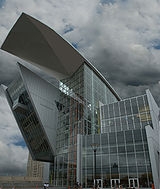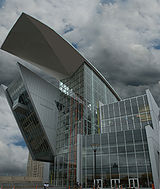
Connecticut Science Center
Encyclopedia

Connecticut River
The Connecticut River is the largest and longest river in New England, and also an American Heritage River. It flows roughly south, starting from the Fourth Connecticut Lake in New Hampshire. After flowing through the remaining Connecticut Lakes and Lake Francis, it defines the border between the...
in Hartford, Connecticut
Hartford, Connecticut
Hartford is the capital of the U.S. state of Connecticut. The seat of Hartford County until Connecticut disbanded county government in 1960, it is the second most populous city on New England's largest river, the Connecticut River. As of the 2010 Census, Hartford's population was 124,775, making...
designed by César Pelli & Associates
César Pelli
César Pelli is an Argentine architect known for designing some of the world's tallest buildings and other major urban landmarks. In 1991, the American Institute of Architects listed Pelli among the ten most influential living American architects...
. It opened on June 12, 2009. The building has a total 154000 square feet (14,307.1 m²) including 40000 square feet (3,716.1 m²) of interactive exhibits consisting of videos, audios, visuals, tactile components, programs, and live demonstrations.
Development
Planning for the Connecticut Science Center began in 2001. The Center's goals are to promote the study of science by the state's youth and to encourage urban revitalization in Hartford. The state of Connecticut provided more than $100 million of support for the $165 million center, and the balance was donated by businesses, foundations and individuals.Leadership in Energy and Environmental Design (LEED) Certifitication
The Connecticut Science Center is the first science center to generate most of its needed power from an on-site fuel cellFuel cell
A fuel cell is a device that converts the chemical energy from a fuel into electricity through a chemical reaction with oxygen or another oxidizing agent. Hydrogen is the most common fuel, but hydrocarbons such as natural gas and alcohols like methanol are sometimes used...
. This step was a major one for the Connecticut Science Center and its steps towards being a Gold Level LEED
Leadership in Energy and Environmental Design
Leadership in Energy and Environmental Design consists of a suite of rating systems for the design, construction and operation of high performance green buildings, homes and neighborhoods....
) Certified green building.
Galleries
http://ctsciencecenter.org/exhibits/http://ctsciencecenter.org/exhibits/Exploring Space
This exhibit defies easy explanation and is truly multimedia. Visitors can examine the moon's ancient craters up close, see a moon rock, strap into a flight chair and take control of the world's first ever Mars Flyover. They can feel try out a Venture to a Black Hole and check out a supernova as they navigate their way through the galaxy.
Forces in Motion
Invention Dimension
This hands-on gallery features inventions and inventors from Connecticut, where visitors can explore and demonstrate for themselves the process of invention.
KidSpace
An adventure filled gallery for kids age 3-6. It features “I Spy” author Walter Wick's search-and-find activities; swirling, whooshing and cascading water play areas, plus a hands-on magnetic ball wall. It's all hands-on to invite experimentation, discovery and interaction.
Picture of Health
This exhibit promotes an understanding of the latest research and technological related to health so visitors can more easily distinguish between bad health habits and good ones that can truly improve the quality of their lives.
River of Life
This exhibit teaches all about the Connecticut River. New England's largest river is vital to Connecticut's history, economy, ecosystems and future energy needs. In this exhibit visitors enjoy an multimedia interactive exploration of its entire 400 miles (643.7 km) trek. No wetsuit required.
Sight and Sound Experience
This gallery is a funky mixture of art, music and science. There are exhibits where visitors can actually feel sound. There are others where they can hear light. Visitors can use lasers, sophisticated software and the movements of their bodies to create perfect harmonies in all kinds of musical stylings, plus multisensory performance art experiences. It's quite unique.
External links
- Connecticut Science Center official site

